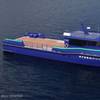Van Oord asked MARIN to perform a full assessment of the hull lines of its new hopper dredger.
Twin gondola aft bodies have been successfully applied to hopper dredgers for many years. This is usually combined with a tunnel head box combination above the propeller. The tunnel leads the water to the propeller, while the head box supports the nozzle and the rudder. However, this results in a very complex shape and consequently, complex flow characteristics.
On top of that the operation profile of a hopper dredger is also challenging; sailing in deep and shallow water at two completely different drafts i.e. fully laden and empty. The question arises about how to keep the flow under control in all these conditions. Full knowledge of the characteristics of the flow around the hull is crucial when designing such a ship. CFD calculations can provide this insight and are, therefore an essential part of the design process.
Operational Profile Vital
Following Van Oord’s request for the assessment of the hull lines of its new hopper dredger, both wave making resistance and the viscous flow around the hull were analyzed, taking into account the aforementioned operational profile of the ship. This emphasis on the operational profile during the design process is increasingly requested by ship owners, and for good reason. Realistically, a hull design can never be 100% suited for every condition the vessel sails in. Therefore, a careful compromise, in close cooperation with the client, has to be made. This requires regular meetings, in which the results of all calculations are put on the screen, and every benefit a hull form shape provides in a certain operational condition is weighted against the possible drawbacks in other conditions. During this process operational knowledge meets hydrodynamic knowledge which results in the best compromise. The project for Van Oord is a good example of this approach.
The assessment and optimization of the hull lines has been conducted with the aid of a variety of MARIN’s programs. For the optimization of the fore body the potential flow code RAPID, which has been used at MARIN for a long time, was deployed. At the bow the effects of viscosity are still limited and the effect of bow variations on wave making resistance can be quickly checked for the selected matrix of operational conditions
Optimal Bulbous Bow
After the optimum bulbous bow was found in this way, the flow along the rest of the hull was examined using the viscous flow codes PARNASSOS and ReFRESCO. The PARNASSOS solver requires a structured calculation mesh. The benefit of such a structured mesh is that the iteration process is fast. However, to enable the use of such a mesh the hull geometry should not be too complex. The PARNASSOS tool has therefore been used in the first stages of the aft body assessment, where the hull was not yet equipped with the tunnel head box combination. The flow characteristics obtained in this way, were used to align the tunnel head box combination with the flow.
In the next stage, when the aligned tunnel head box combination was fitted to the hull, the hull was examined again, but now the geometry had become so complex that a viscous flow code, which is capable of solving unstructured meshes had to be used. Therefore, for this stage, MARIN’s code ReFRESCO was applied. The calculated flow characteristics were examined with respect to flow separation and the generation of vortices in areas where they could negatively influence efficiency and vibrations. Similar to the aforementioned analysis, different loading and water depth conditions were examined in accordance with the selected matrix of operational conditions.
The innovative hull design passed the test with very good results, in both deep and shallow water. At the time of writing this article the final validation by means of model tests was about to start. During this stage, the performance of the hull will again be investigated in deep and shallow water.
About the Author
Luigi Francesco Minerva is Project Manager of the Ships Department of MARIN, the Maritime Research Institute Netherlands. MARIN offers simulation, model testing, full-scale measurements and training programmes, to the shipbuilding and offshore industry and governments.
w. www.marin.nl.
As published in the October 2015 edition of Maritime Reporter & Engineering News -- http://digitalmagazines.marinelink.com/nwm/MaritimeReporter/201510/













